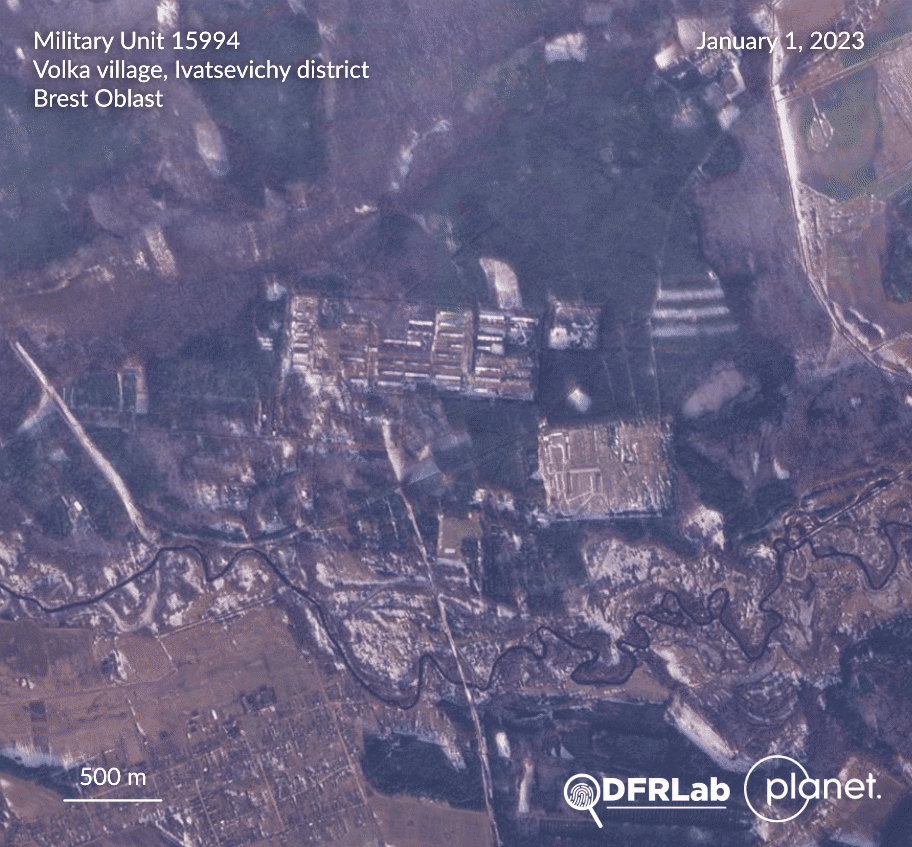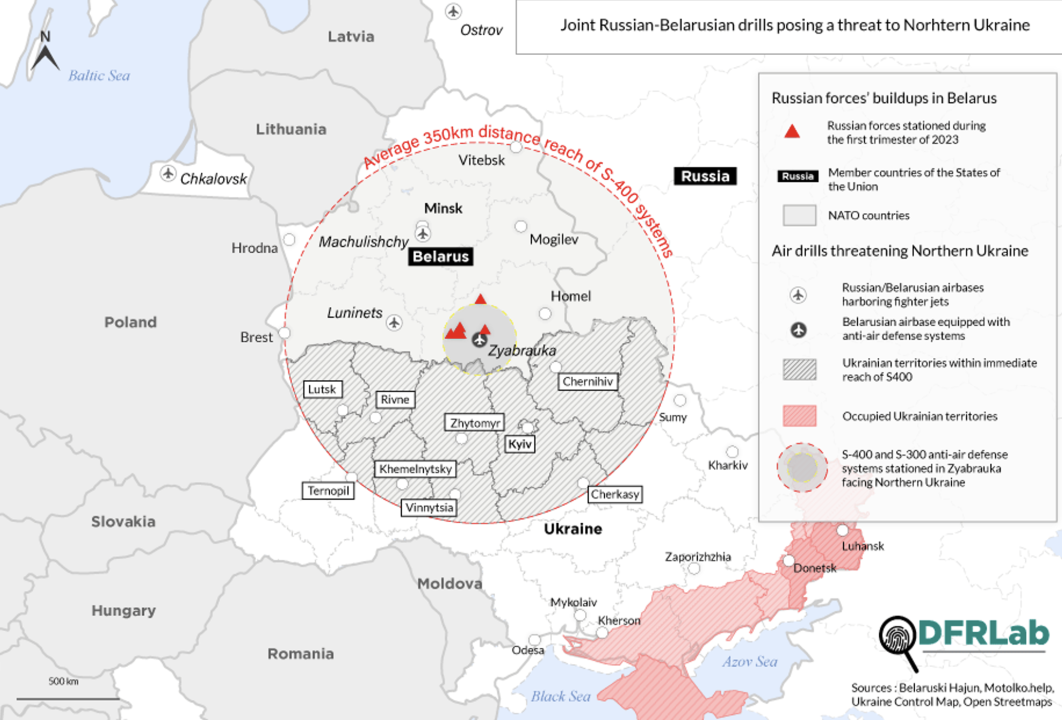Ongoing Russian-Belarusian drills keep up the pressure on northern Ukraine
Joint military drills repeatedly extended by Russia and Belarus put Ukraine’s northern border within missile range
Ongoing Russian-Belarusian drills keep up the pressure on northern Ukraine
Share this story

BANNER: A Russian MiG-31 fighter jet equipped with a Kinzhal hypersonic missile flies over Moscow’s Red Square during a rehearsal for a flyover, part of an annual military parade marking the anniversary of the victory over Nazi Germany, May 7, 2022. (Source: Reuters/Maxim Shemetov)
As the Russian offensive on eastern Ukraine struggled to make progress, Belarus increased its cooperation with Russia, deploying additional military capacity to maintain pressure on Kyiv and its surrounding area. Offensive positions near the northern Ukrainian border with Belarus have also expanded as Russia and Belarus continue to extend joint military exercises.
The Belarus-Ukraine border was amongst the first to open the road to Russian soldiers paving the way for Russia’s February 2022 invasion. As recently as February 2023, Belarusian President Alyaksandr Lukashenka has reiterated that his country would join forces with Russia if attacked. The ongoing presence of Russian ground forces, military equipment, and aircraft on Belarusian soil continue to exacerbate concerns regarding Belarus potentially expanding its involvement in the conflict.
In December 2022, Ukrainian Armed Forces Commander-in-Chief Valeryi Zaluzhnyi warned that a northern invasion could once again be on the horizon. His concerns were reinforced after the Kremlin issued an executive order in January 2023 vowing to increase cooperation in Belarus and establish “joint military preparation training combat centers.” This policy is also consistent with the enhanced presence of Russian Motor Divisions across Belarusian territory, as well as that of armored personnel carriers and Russian Air Force fighters and reconnaissance aircrafts. In response, Ukraine has expanded its presence near the border.
To better understand how Russian-Belarusian cooperation attempts to stretch Ukraine’s military resources and act as psychological leverage against its civilian population, the DFRLab analyzed available open-source evidence documenting Russian military presence in Belarus, establishing the classes of aircrafts and weapons Russia relocated to Belarusian military control centers.
Russian materiel and manpower deployed to Belarus
While joint training officially kicked off on January 16, 2023, information posted by Belarusian open-source monitoring project Motolko indicates that the training exercises actually began nine months earlier in April 2022 and have continued ever since through a series of extensions. In December 2022, Russia started relocating parts of its ground forces and military equipment to Belarus, ahead of air-drills that were to take place in January 2023. In the weeks preceding official communication by the two countries’ defense ministries, open-source analysts and local monitoring initiatives identified Russian military equipment on trains headed toward Belarusian territory. Together with the deployment of additional Russian soldiers, the military exercises have enabled Russia to sustain its military presence in Belarus. Reports from January 2023 also indicated Russian soldiers underwent training in Belarus prior to re-deploying to the Luhansk region of Ukraine to engage Ukrainian troops fighting in the Donbas.
Arsenal transfer document using social media footage on railways
Open sources documented transfers of Russian military equipment via rail to Belarus as early as the end of December 2022. Geolocated footage of several APCs, military trucks, and armored vehicles indicated that armed reinforcement had been deployed to Belarus’s most prominent military bases. Open-source investigators noted activity in three southern military polygons in Belarus – Brest in western Belarus, near the Polish border; and Mazyr and Homel in eastern Belarus, a couple dozen kilometers north of Ukraine’s Chernihiv Oblast. Russian ground forces equipment was spotted moving by rail toward Minsk prior to relocation elsewhere.
Photographs dating back January 5, 2023 appeared on Russian social media platform VKontakte showing thirty-four Russian military BTR-82A and BTR-80K armored vehicle units relocating to Brest. Four days later on January 9 in Baranavichi, Brest Oblast, Twitter users posted and geolocated photos of Russian military equipment.
A video clip posted to TikTok on January 14 indicated armored vehicles were being dispatched in Belarus. Using plate registration databases and photograph forensics, the DFRLab identified a dozen MAZ-5316 Belarusian military trucks likely containing equipment and ammunition, as well as ZIL-131 Soviet-era trucks. Several units of Belarusian-manufactured Kaiman armored reconnaissance combat vehicles were also identified.
In a March 31 speech to Belarusian parliament, President Lukashenka claimed that Belarusian instructors were training the Russian army. “Since last fall, the Russian army’s forces have been on rotation in Belarusian military centers,” he said. “The forces are undergoing preparation and are prepared to act together to protect our common security space.”
Extended rotations sustaining Russian arsenal and servicemen in Belarus
During the first three months of 2023, Russia dispatched artillery and ground forces divisions comprising at least six thousand Russian troops to Belarusian military camps. Citing data from the Ukrainian Center for Defense Strategies, Project Owl’s Ukraine Control Map reported the deployment of four Russian divisions in Belarus by the end of February 2023, including the 6th Motor Rifle Division of the 3rd Army Corps, as well as the 11th, 51st, and 295th Motor Rifle Divisions.
The presence of Russian military divisions has sustained over time due to Russia repeatedly extending joint exercises with Belarus. At the time of writing, the most recent round of exercises that were scheduled for completion in early June have again been extended until June 25, with further extensions likely to follow. Meanwhile, reports published by RFE/RL and the independent Belarusian military monitoring project Belaruski Hajun indicate that Russia rotates drafted servicemen for training at several military camps in Belarus on a monthly basis.
In April, open-source monitoring project Motolko assessed that Russian armed forces regiments were present at four different training camps in Belarus. The article appeared as Russian Defense Minister Sergey Shoigu publicly thanked Lukashenka for his assistance in providing training for both armies. The DFRLab found evidence of activity and troop rotations at two of these locations.
The DFRLab observed rotation maneuvers in the Abuz-Lyasny military camp near Baranavichy, Brest Oblast, throughout January, February, and March 2023. Previous analysis of satellite and other imagery by RFE/RL identified tents and other equipment at the camp; the DFRLab’s independent findings corroborated these findings and additionally observed a rotation of soldiers seemingly departing the camp around March 18, 2023. According to RFE/RL’s estimates, Abuz-Lyasny had hosted as many as one thousand troops that month.

Using public databases and satellite imagery, the DFRLab also identified another revamped military training camp in the vicinity of Volka and Domanava, approximately sixty kilometers southwest of Baranavichy. The DFRLab collected satellite imagery of the facility, indicating areas newly cleared of forest that possibly point to expansion of the military camp. Geographic information indicated that military units 42276 and 15994 had been dispatched to the area, despite the fact that historic military registries suggested these units had been decommissioned in November 2013. This claim appears to be incorrect or outdated, however; in 2018, both military units took part in a study researching soldiers engaging in hazing rituals in the vicinity of Volka. Additional data published by Belaruski Hajun indicated four separate cargo deployments in the area in January 2023. This information strongly hints at a resumption of military activity around the training camp.

Joint air drills keep pressure on NATO allies and Ukraine
Parallel to the military exercises in which the Russian ground forces took part, Russian and Belarusian air forces announced in January 2023 that they would hold military air drills. These aerial exercises consisted of deploying fighter jets and reconnaissance aviation to Belarusian airbases, including ones close to the border with Ukraine. The air drills also consisted of conducting test missile strikes that triggered Ukrainian air alerts across northern parts of the country. Additionally, Belarus participated in Russian deployments of aerial power to Kaliningrad, violating international borders in the Baltic Sea.
During the Belarusian and Russian air drills, interceptions in the Baltic Sea were confirmed throughout January by Lithuania’s Ministry of Defense. On one occasion, the DFRLab identified a Belarusian military cargo aircraft taking part in Russia’s military deployments returning to a naval air base in Chkalovsk, Kaliningrad, along the Baltic Sea. Belarus is a landlocked country without access to the Baltic Sea whose civilian aviation is prohibited to operate over European airspace. This prohibition has been in place ever since Belarusian authorities declared a commercial flight from Athens to Vilnius to be the target of a bomb threat, only for it later to be revealed that the threat was faked as a means of grounding the plane in Belarusian territory in order to detain Belarusian activist Roman Protasevich and his girlfriend in 2022.
On January 27, 2023, Twitter account @Acher83Able posted footage of an incident in which Russian fighters, together with a Belarusian Ilyushin-76MD military cargo plane bearing the registration plate EW-005DE, were intercepted over the Baltic Sea.
The Lithuanian Ministry of Defense (MoD) posted information to its website indicating that Belarus and Russia had conducted air drills over the Baltic Sea, including Kaliningrad.
On January 31, a Twitter user indicated that an Ilyushin-76MD military cargo aircraft with the same registration plate was en route to the Chkalovsk air base in Kaliningrad. The Ilyushin Il-76MD took off from the Ostrov military air base in Pskov Oblast, Russia. The footage confirmed that it had flown over international waters in the Baltic Sea, which triggered NATO F-16 air fighters as well as a Swedish Gripen fighter to escort it, as it was accompanied by two Russian Sukhoi-27 fighters with their transponder turned off. NATO aircraft are deployed as part of the Baltic states’ membership to the alliance, which provides them with aircraft administered by other member-states. Violation of national airspace, and failure to comply with instructions requesting that military aircraft establish routes outside of national airspaces trigger interceptions, as per the NATO sky policing mission in the Baltic Sea. Later reports suggested the aircraft had landed by 6:30 p.m. local time at Machulyshchy air base in Belarus.
The novelty of this operation relies on the use of both Russian and Belarusian military aviation to conduct operations over the Baltic Sea. As confirmed by the Lithuanian MoD, more interceptions occurred throughout February and March.
Psychological leverage as fighter jets stationed in Belarus trigger air alarms in Ukraine
Fighter jets taking off from Belarus have triggered air raid sirens in Ukraine on several occasions. The DFRLab compiled data from Belaruski Hajun listing occasions of fighters taking off, as well as Ukrainian air-raid siren alerts posted via the Air Alarm Telegram channel (@air_alert_ua).

The datasets consisted of data dating from April 2022 to March 14, 2023. Between these dates, the northern Ukrainian oblasts of Rivne, Zhytomyr, Sumy, Kyiv, and Chernihiv experienced air-raid alerts on sixty-four days. Of these, forty-four coincided with Belarusian military operations, including fighter jets taking off and conducting exercises with the Russian Armed Forces.
The DFRLab created an interactive map visualizing the air alerts issued per day, in correlation with events related to fighter jets taking off from Belarusian air bases from April 2022 until March 14, 2023. Notably, fighter jets located at Belarusian air bases in Baranavichy, Machulishchy, and Lida have consistently triggered air alerts across Ukraine’s northernmost oblasts from the beginning of the invasion until at least mid-March 2023.
On numerous occasions, Russian MiG-31K fighters were suspected of being equipped with Kinzhal missiles, which Ukraine’s air-defense capacity had struggled to intercept prior to the introduction of Patriot missile batteries. While Russia’s supply of Kinzhals is by no means infinite – Ukrainian Defense Minister Oleksii Reznikov estimated in May that Russia possessed fewer than eighty of them – cooperation with Belarus in conducting air drills with potentially hypersonic missiles has kept the civilian population in northern Ukraine under pressure.
Belarusian airfields serving as offensive bases
As early as January 2023, Belarusski Hajun identified S400 and S300 missile systems deployed at the Belarusian military air base in Zyabrauka, only eighty kilometers away from the Ukrainian city of Chernihiv.

Private investigating company Rochan Consulting released satellite imagery sharing the location of S300 or S400 systems in the airbase. The imagery also showed anti-aircraft Panzir systems south of the runway. These weapon systems’ missile range stretches up to 380 km, putting critical Ukrainian infrastructure in a potential attack zone. The S400 anti-air defense system suspected in Zyabrauka was likely transferred from the Russian arsenal as early as December 2022.

According to our analysis, at least one S300 or S400 air-defense missile system was still deployed Zyabrauka as of March 14, 2023. This information is consistent with further deployments observed by Motolko. Footage released by official channels in Belarus leaked the location of a moving column of S400 missile systems near Gomel, approximately one hundred kilometers north of Chernihiv. Motolko assessed that these deployments were highly likely to be headed to the Zyabrauka airbase. These deployments have also been accompanied with the creation of a new anti-air protection regiment in Luninets, located in central southern Belarus not far from the Ukraine border. The new regiment is yet another sign of the remilitarization of Belarus’s southern military control centers facing Ukraine; it is also consistent with recent reports regarding the deployment of Russian nuclear warheads in Belarusian territory.
Overall, the DFRLab’s assessment of the joint drills that have taken place continuously since April 2022 suggests that Belarus and Russia continue to revamp and coordinate offensive positions facing Ukraine and neighboring NATO countries. Military cooperation has enabled Russia to transfer parts of its arsenal to Belarus under the pretense of extended exercises, keeping pressure on Ukraine’s military while simultaneously continuing to psychologically impact the Ukrainian public.
Cite this case study:
Valentin Châtelet, “Ongoing Russian-Belarusian drills keep the pressure on northern Ukraine,” Digital Forensic Research Lab (DFRLab), June 23, 2023, https://dfrlab.org/2023/06/23/russian-belarusian-drills-broadened-threat-to-ukraine/

